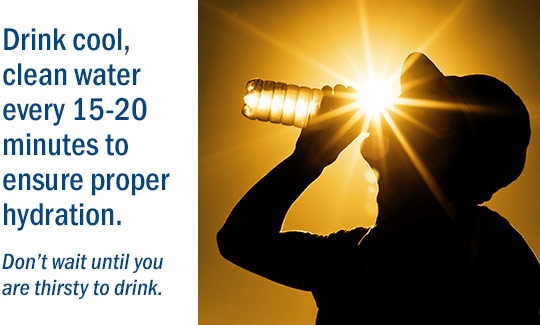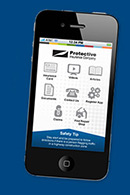| Know the signs and symptoms of heat-related illnesses |
| Summer is here! But with that comes extreme heat. According to the National Institute for Occupational Safety and Health (NIOSH), overheating and heat exhaustion are major contributors in preventable accidents and injuries. |
| Heat-related illnesses often affect those with outdoor jobs during hot weather, but they can also affect those working in hot conditions such as docks, warehouses and maintenance shops. In severe circumstances, prolonged exposure to heat can cause heat stroke, liver or kidney failure and even death. |
| Some factors leading to heat-related illnesses include high temperatures or high humidity, the amount of sun exposure, limited air circulation, your level of physical exertion and physical condition, certain medications and what clothing you are wearing. |
 |
| Educate yourself on how to recognize and avoid heat-related illnesses with the tips below and on our free handout. |
| Signs of a heat-related illness: |
| • Sunburn: Caused by overexposures to sunlight. Pain/discomfort, redness or blistering/peeling of skin. |
| • Heat rash: Caused by clogged sweat ducts. Red rash and itching. |
| • Fainting: Caused by not being accustomed to the heat. Feeling weak, dizzy and/or exhausted, about to lose consciousness. |
| • Heat cramps: Painful spasms of the muscles caused by salt loss. Sudden onset, hot/moist skin, normal pulse, normal to slightly high body temperature. |
| • Heat exhaustion: Caused by loss of large amount of fluids through heavy sweating. Intense thirst from dehydration, cool, moist skin (clammy and pale), weak and rapid pulse, low to normal blood pressure, extreme fatigue, weakness or loss of coordination, nausea, headaches and/or delirium. |
| • Heat stroke: Caused when the body can no longer regulate its temperature. |
| ◦ Early symptoms: Body temperature above 103 degrees; absence of sweating; red, hot or flushed dry skin; rapid pulse; difficulty breathing; constricted pupils; high blood pressure; headache or dizziness; confusion or delirium; bizarre behavior; weakness; and/or nausea or vomiting. |
| ◦ Advanced symptoms: Seizure or convulsions, fainting, deep coma, no detectable pulse and/or body temperature over 108 degrees. |
| How to beat the heat: |
| • Drink plenty of cool, clean water. Don’t wait until you are thirsty to drink. Being thirsty is your body telling you you need water. Drink every 15-20 minutes to ensure proper hydration. |
| • Eat well-balanced, low sodium meals and avoid alcohol or caffeinated beverages as they will further deplete your body of fluids and cause dehydration. |
| • Dress appropriately by wearing a hat and light-colored, loose-fitting clothing. |
| • Get plenty of rest. Fatigue can put additional stress on your body and make you more susceptible to heat exhaustion. |
| • Avoid excessive sun exposure. If possible, schedule the most strenuous activities/tasks for early morning or night. Use sunscreen to prevent sunburn. |
| • Take frequent breaks, preferably in a cool or shaded place. |
| If you think you are experiencing heat stroke, pull off in a safe, legal parking location and call 911 immediately. If you’re in a warehouse or dock, your coworkers should move you to a cool place after calling 911 and use any resources available to bring down your body temperature such as a wet cloth, ice pack, cold water or fanning. Do not wait. Take action fast! |
| For more information on hot weather safety: |
| • National Safety Council |
| • American Red Cross |
| • Occupational Safety & Health Administration (OSHA) |
| Free download: Beat the Heat |
| Download our handout to keep cool and educate yourself on how to recognize and avoid heat-related illnesses. Download handout >>
|
|
| Download the Protective mobile app!
|
| The Protective mobile app enables customers to easily submit claims, view vehicle ID cards, get the latest safety updates and more. Click to download for iPhone or Android today! |
| Note: Not all features are available to all customers. Please refer to the app's description in the App Store or Google Play for full details. |
|  |
|
